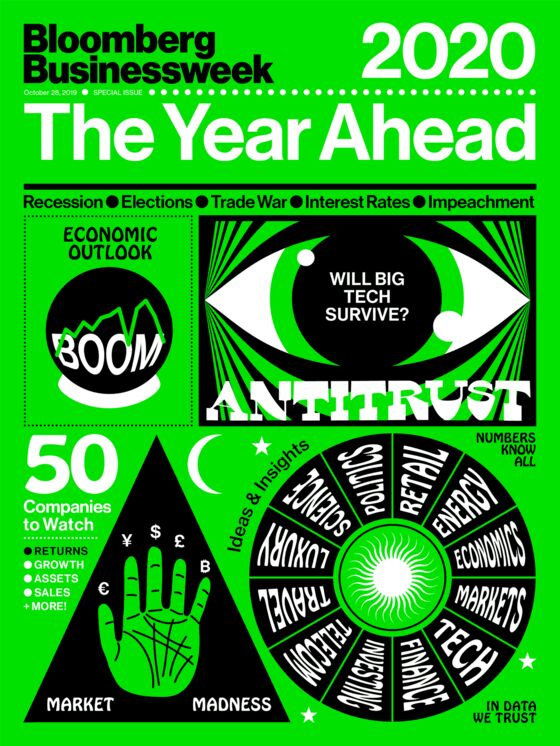VW’s $50 Billion Moonshot Bet on an Electric Hatchback
VW’s $50 Billion Moonshot Bet on an Electric Hatchback
(Bloomberg Businessweek) -- At major global car exhibitions, Volkswagen AG typically presents itself as a big, happy family, where each brand—budget-oriented Seat and Skoda, VW proper, luxury Audi, road rockets Porsche, Lamborghini, and Bugatti—gets equal time to flaunt its latest innovations. But in Frankfurt this September, the choreography was different, with the company devoting the entire preshow press conference to a single diminutive model: an all-electric hatchback called the ID.3.
As reporters and industry grandees gathered in a cavernous exhibition hall, videos depicted lush mountain landscapes to a soundtrack of chirping birds and New Age music. To highlight the breadth of VW’s ambitions for the ID.3, a parade of prototype electric vehicles from years past made cameos. Finally, the lights went dark, the music picked up, and a trio of ID.3s drove onstage—the only auto the company showed that evening. “This is an electric car for the people that will move electric mobility from niche to mainstream,” Chief Executive Officer Herbert Diess told the crowd.
It’s a moonshot bet for a manufacturer trying to reinvent itself four years after it admitted to cheating on diesel emissions tests—a scandal that has cost VW more than $30 billion. That painful experience shocked the company into a radical reboot and a commitment to spend almost $50 billion on electric vehicles, more than any other automaker. After years of planning and promises, in 2020 VW will begin to see whether that massive investment is likely to pay off.

The ID.3, scheduled to hit the streets by midyear, is the first of at least 70 electric cars in VW’s pipeline. It will begin rolling off German assembly lines in November, and in 2020 two factories in China will start production, allowing VW to build more cars annually than Tesla Inc. has sold in its entire history. By 2022 the company expects to have eight facilities around the globe making battery-powered vehicles, from the ID.3 to cargo vans to Porsche’s four-door Taycan.

Diess, an automotive industry lifer who climbed the ranks at BMW AG and supplier Robert Bosch, has told managers that the electric initiative can help more than double VW’s market value, to €200 billion ($223 billion), according to people familiar with the target. Yet with the global economy showing signs of sputtering, the timing is risky. Auto sales in China, the biggest market, are heading south at an unprecedented rate, and a wider downturn would surely cut demand for new vehicles, electric or not. This is happening as automakers grapple with the unresolved trade war between China and the U.S. and the unpredictability of Brexit. Potential customers, meanwhile, remain deeply concerned about driving range and a patchy charging infrastructure. “The industry is facing a double whammy,” says Fabian Brandt, a partner at consulting firm Oliver Wyman. “They’re managing a crisis of weakening demand while grappling with a generational shift.”
VW’s record on big initiatives such as the electric push isn’t great, as the company has often been hobbled by its sprawling footprint, an ownership structure that grants a controlling stake to the heirs of the creator of the Beetle, and bylaws that give workers and political stakeholders major sway over key decisions. Constantly taking into account the diverging interests of management, the controlling clans, labor unions, and the German state of Lower Saxony can bog down decision-making. Audi stumbled with a would-be challenger to Tesla’s Model X, the e-Tron, which hit the market in April, six months later than planned, and shortly thereafter was recalled over concerns about fire risk in its battery.
While the ID.3, priced from around $30,000 with a range of 200 miles or more, is aimed at countering the threat from Tesla’s Model 3, its stiffest competition will come from gasoline-powered cars such as VW’s own Golf hatchback. The company has made an electric Golf since 2012, but the vast majority of sales are for combustion versions, and Volkswagen on Oct. 24 plans to unveil the latest iteration of the model as it seeks to straddle the old and new worlds. The Golf, though, also offers an object lesson in how Volkswagen can change when it gets things right. VW built its global brand after World War II with the Beetle. Then with sales of the Beetle tapering off, in 1974 the company introduced the Golf, which catapulted it to the top of the European industry. By applying that same sort of focus to its e-car push, “VW could wind up coming through the CO2 challenge as a winner,” says Tom Narayan, an analyst with RBC Capital Markets. “The ID.3 is the cornerstone of the whole thing.”
To contact the editor responsible for this story: David Rocks at drocks1@bloomberg.net
©2019 Bloomberg L.P.